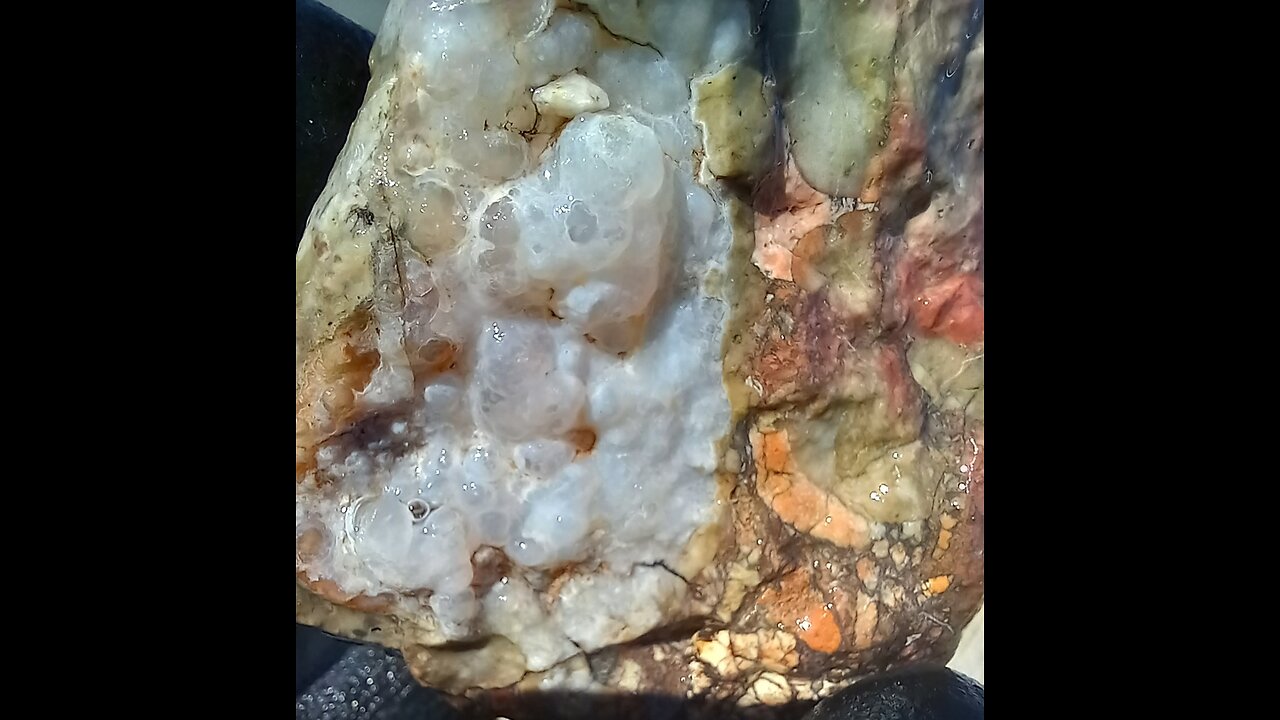Premium Only Content

Botryoital Opal w/ A Little of Everything!
Opal is a hydrated amorphous form of silica, with a water content typically between 3 and 21% by weight, most commonly around 6-10%. It's deposited at relatively low temperatures and can be found in the fissures of various rock types, including limonite, sandstone, rhyolite, marl, and basalt. Here's a deeper look into opal:
Types of Opal:
Precious Opal: Known for its "play-of-color," which is an optical phenomenon where colors flash or change as the angle of light or observation changes. This effect is due to the diffraction of light through the microscopic silica spheres within the opal.
Common Opal: Lacks the play-of-color and can come in a variety of colors like white, black, grey, yellow, orange, red, or brown. It's often referred to as "potch" when not gem-quality.
Fire Opal: Typically ranges in color from yellow to orange to red and can be transparent to translucent. Fire opals can exhibit play-of-color, but their name comes from the fiery body color.
Boulder Opal: A type of opal naturally attached to its host rock. It's often cut with the host rock to provide stability and to enhance the visual appeal.
Matrix Opal: The opal fills the cracks and cavities within the host rock, creating a network of opal that's visible on the surface.
Formation:
Primary Opal: Forms through the slow deposition of silica from groundwater in cavities or fractures of rocks.
Secondary Opal: Can form by weathering or alteration of other minerals, often in more superficial environments or through the action of silica-rich waters.
Locations:
Australia: The world's leading source, especially for precious opal, with significant deposits in places like Coober Pedy, Lightning Ridge, and White Cliffs.
Ethiopia: Known for its black opals and more recently discovered opal fields.
Mexico: Famous for fire opals.
Brazil: Produces a variety of opals, including crystal opal.
Properties:
Hardness: Typically ranges between 5.5 to 6.5 on the Mohs scale, though it can be softer if less hydrated or harder if more silica-rich.
Luster: Can range from waxy to resinous to vitreous.
Transparency: Varies from opaque to semi-translucent to transparent.
-
 LIVE
LIVE
The Charlie Kirk Show
1 hour agoBury Harvard + Defund NPR + The "Maryland Dad" Lie | Vought, Davis, Kane | 4.15.25
3,739 watching -
 43:40
43:40
Winston Marshall
2 hours ago30 Politically Motivated Deaths in 2025 So Far…Tim Pool Uncovers Civil Strife in America
4.87K4 -
 LIVE
LIVE
Rebel News
45 minutes agoPoilievre on defunding CBC, Carney on climate change, PPC candidate's bank frozen | Rebel Roundup
611 watching -
 LIVE
LIVE
Flyover Conservatives
2 hours agoRUSSIAGATE: Steele Dossier was FAKE the Whole Time... and They Knew It! - Hans Mahncke | FOC Show
450 watching -
 LIVE
LIVE
TheAlecLaceShow
4 hours agoGuest: Mayor JD Longo | Bukele Visits Trump | Assassination Plots | Tax Day | The Alec Lace Show
52 watching -
 38:18
38:18
Grant Stinchfield
1 hour agoCDC Records Vanish: Top Vaccine Safety Administrator's Files Missing Amid Federal Probe
1.6K7 -
 1:02:25
1:02:25
Steven Crowder
4 hours ago🔴 Qatar: The Small Gulf State with Portentous Global Influence
207K144 -
 2:34:36
2:34:36
Tate Speech by Andrew Tate
9 hours agoEMERGENCY MEETING EPISODE 109 - KNIFE CRIME ON MARS
67.5K52 -
 1:06:19
1:06:19
The Rubin Report
2 hours agoTrump, Bukele & Bondi Relentlessly Drill Reporter w/ Facts About Deported Gang Member
27.4K30 -
 1:00:56
1:00:56
VINCE
5 hours agoPresident Trump The Businessman Strikes Again | Episode 22 - 04/15/25
221K232